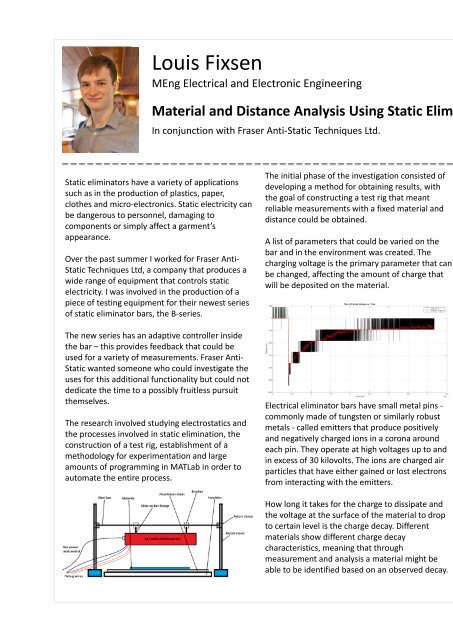UWE Bristol Engineering showcase 2015
You also want an ePaper? Increase the reach of your titles
YUMPU automatically turns print PDFs into web optimized ePapers that Google loves.
Louis Fixsen<br />
MEng Electrical and Electronic <strong>Engineering</strong><br />
Material and Distance Analysis Using Static Eliminators<br />
In conjunction with Fraser Anti-Static Techniques Ltd.<br />
Static eliminators have a variety of applications<br />
such as in the production of plastics, paper,<br />
clothes and micro-electronics. Static electricity can<br />
be dangerous to personnel, damaging to<br />
components or simply affect a garment’s<br />
appearance.<br />
Over the past summer I worked for Fraser Anti-<br />
Static Techniques Ltd, a company that produces a<br />
wide range of equipment that controls static<br />
electricity. I was involved in the production of a<br />
piece of testing equipment for their newest series<br />
of static eliminator bars, the B-series.<br />
The new series has an adaptive controller inside<br />
the bar – this provides feedback that could be<br />
used for a variety of measurements. Fraser Anti-<br />
Static wanted someone who could investigate the<br />
uses for this additional functionality but could not<br />
dedicate the time to a possibly fruitless pursuit<br />
themselves.<br />
The research involved studying electrostatics and<br />
the processes involved in static elimination, the<br />
construction of a test rig, establishment of a<br />
methodology for experimentation and large<br />
amounts of programming in MATLab in order to<br />
automate the entire process.<br />
The initial phase of the investigation consisted of<br />
developing a method for obtaining results, with<br />
the goal of constructing a test rig that meant<br />
reliable measurements with a fixed material and<br />
distance could be obtained.<br />
A list of parameters that could be varied on the<br />
bar and in the environment was created. The<br />
charging voltage is the primary parameter that can<br />
be changed, affecting the amount of charge that<br />
will be deposited on the material.<br />
Electrical eliminator bars have small metal pins -<br />
commonly made of tungsten or similarly robust<br />
metals - called emitters that produce positively<br />
and negatively charged ions in a corona around<br />
each pin. They operate at high voltages up to and<br />
in excess of 30 kilovolts. The ions are charged air<br />
particles that have either gained or lost electrons<br />
from interacting with the emitters.<br />
How long it takes for the charge to dissipate and<br />
the voltage at the surface of the material to drop<br />
to certain level is the charge decay. Different<br />
materials show different charge decay<br />
characteristics, meaning that through<br />
measurement and analysis a material might be<br />
able to be identified based on an observed decay.<br />
The static eliminator was used to charge and<br />
discharge the material, with the voltage from the<br />
current measurement ‘C-SENSE’ module giving a<br />
relative measure of the current at the bar’s pins.<br />
Measurements were obtained using a PicoScope<br />
digital oscilloscope connected to debug outputs<br />
from the bar. The bar was controlled using a<br />
MATLab script that also controlled the<br />
oscilloscope. The material beneath the bar was<br />
charged and discharged whilst the oscilloscope<br />
gathered data.<br />
Distance estimation using the B12 bar appears to<br />
be possible. If the material is known then the peak<br />
value of the charging and discharging decays give a<br />
good indication of the distance – within a certain<br />
range.<br />
Curve fitting tools would allow for accurate<br />
material and distance estimation. Individual<br />
parameters cannot be used to differentiate<br />
between different curves, each material was found<br />
to have an identifiable decay curve with noticeable<br />
characteristics. Use of curve fitting would allow<br />
these to be stored and compared against new<br />
data.<br />
Project Supervisor<br />
Nigel Gunton<br />
Project summary<br />
The aim of this research investigation was to discover<br />
how effectively an electrical static eliminator bar<br />
could be used for material and distance analysis.<br />
Initial work included a literature survey and research<br />
into static eliminators, charge decay and other topics.<br />
A test rig was designed and constructed in order to<br />
produce repeatable measurements to assess the<br />
reliability results. MATLab scripts that handled bar<br />
control and data acquisition were written. Data was<br />
analysed and used to write a script that could<br />
estimate what material was beneath the bar or the<br />
distance between the bar and material, which was<br />
partially successful<br />
Project Objectives<br />
• Construct a test rig that allowed for repeatable<br />
measurements.<br />
• Obtain reliable results using the bar to charge and<br />
discharge a material.<br />
• Conduct large scale data acquisition with multiple<br />
materials and distances.<br />
• Find parameters that varied with material and<br />
distance.<br />
• Use these in script to estimate material or<br />
distance.<br />
Project Conclusion<br />
The investigation was mostly success. Measureable<br />
changes in voltage from the C-SENSE module were<br />
recorded relative to the current draw at the pins of<br />
the static eliminator bar with changes in distance and<br />
material. It was not possible to create a script that<br />
could estimate using simple parameters, more<br />
complex data analysis is needed. It is significant that<br />
through analysing feedback from the bars the type of<br />
plastic that is beneath the bar, or the distance<br />
between the bar and material can be given. It means<br />
that development of even more ‘intelligent’ bars is<br />
possible.


